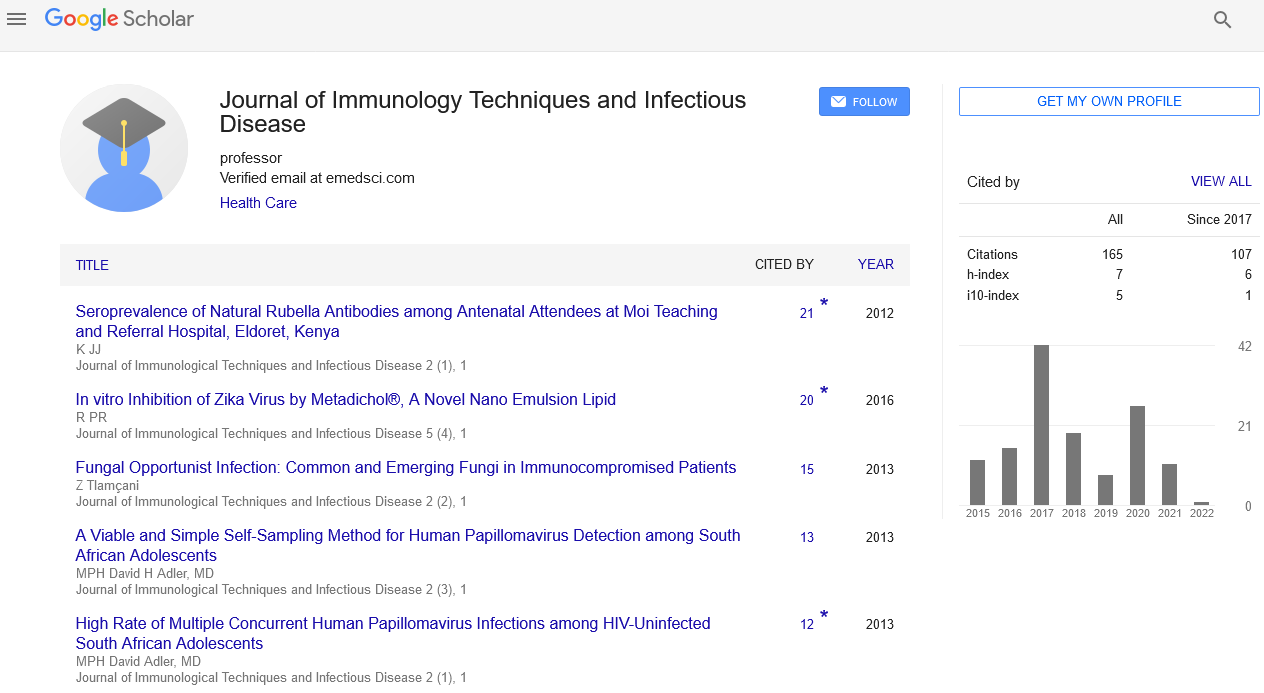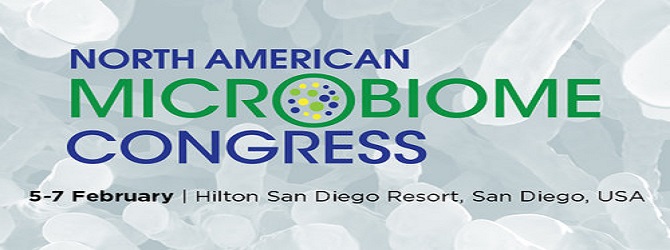Short Communication, J Immunol Tech Infect Dis Vol: 5 Issue: 3
Immunochromatographic Assay for Detection of Mycobacterium Tuberculosis Complex in Clinical Isolates at Instituto de Infectologia Emilio Ribas, Brazil
| Eira M1*, Moreira IM1, Costa Silva RJ1, Boccardo EJ1, Souza SA2, Carvalho ALI2, and Oliveira Junior FI1 | |
| 1Infectology Section, Instituto de Infectologia Emílio Ribas, São Paulo, Brazil | |
| 2Clinical Laboratory Division, Instituto de Infectologia Emílio Ribas, São Paulo, Brazil | |
| Corresponding author : Margareth da Eira
Centro de Estudos Emílio Ribas, Av. Dr. Arnaldo, 165, Cerqueira César – São Paulo/SP – Brazil Tel: 55-11-3088-8366 E-mail: margaeira@uol.com.br |
|
| Received: August 01, 2016 Accepted: August 11, 2016 Published: August 14, 2016 | |
| Citation: Da Eira M, Moreira IM, Da Costa Silva RJ, Boccardo EJ, De Souza SA, et al. (2016) Immunochromatographic Assay for Detection of Mycobacterium Tuberculosis Complex in Clinical Isolates at Instituto de Infectologia Emilio Ribas, Brazil. J Immunol Tech Infect Dis 5:3. doi:10.4172/2329-9541.1000148 |
Abstract
Immunochromatographic Assay for Detection of Mycobacterium Tuberculosis Complex in Clinical Isolates at Instituto de Infectologia Emilio Ribas, Brazil
Tuberculosis results in an estimated 1.5 million deaths each year and the worldwide number of new cases continues high. For decades, tuberculosis diagnosis in high-burden countries was almost completely based on sputum microscopy. Increasing rates of drug-resistance remains a severe threat that has drawn greater attention from worldwide tuberculosis control programs. We evaluated the performance of TB Ag MPT64 Test directly from 554 BACTEC MGIT 960 (or BACTEC FX, for blood and bone marrow) culture-positive samples: 391 were identified as M. tuberculosis complex and 95 as nontuberculosis mycobacteria. This immunochromatographic assay is easy, sensitive, and does not require a high level of skill or specific equipment. Since 2015, the implementation of Xpert MTB/RIF system is happening in Brazil supported by the Ministry of Health of Brazil, and this diagnostic technology provides a rapid diagnostic test for tuberculosis and rifampicin resistance.
Keywords: Tuberculosis; Diagnostics; Drug-resistance; Immunochromatographic assay
Keywords |
|
| Tuberculosis; Diagnostics; Drug-resistance; Immunochromatographic assay | |
Short Communication |
|
| Tuberculosis (TB) is one of the major public health problems that World Health Organization (WHO) has faced over the last 50 years. Twenty two low-income and middle-income countries account for more than 80% of the active cases in the world – the 22 high-burden countries. In 2014, there were an estimated 9.6 million new TB cases and 1.5 million TB deaths, including 400,000 deaths in patients coinfected with HIV. Men were more likely than women to have the disease: 5.4 million among men, 3.2 million among women and 1.0 million among children [1,2]. Approximately 90% of total TB deaths (among HIV-negative and HIV-positive people) and 80% of TB deaths among HIV-negative people occurred in the African and South-East Asia Regions in 2014. Due to devastating effect of HIV on susceptibility to tuberculosis, sub-Saharan Africa has been disproportionately affected in this co-infection [3]. The number of TB deaths is unacceptably high considering that with a timely diagnosis and correct treatment, almost all people with TB can be cured. | |
| Over the past two decades there has been the worldwide emergence of multidrug-resistant tuberculosis (MDR tuberculosis – with resistance to at least isoniazid and rifampicin), and more recently strains extensively drug-resistant (XDR tuberculosis – with mycobacteria resistant to rifampicin and isoniazid, any fluoroquinolone, and one of the three injectable aminoglycosides) [4-6]. Of the 480,000 cases of multidrug-resistant TB (MDR-TB) estimated to have occurred in 2014, only about 123,000 patients were detected and reported. Extensively drug-resistant TB had been reported by 105 countries by 2015. An estimated 9.7% of people with MDR-TB have XDR-TB [1]. | |
| Laboratory confirmation of TB and drug resistance is essential to ensure that individuals with TB are correctly diagnosed and have access to the appropriate treatment as soon as possible [7]. To help with increased detection, the definition of smear-positive tuberculosis has been changed, such that one positive sputum smear of two (collected at the same day, to reduce costs) is sufficient for the diagnosis of tuberculosis [8]. In a resource-limited setting country, conventional smear microscopy forms the basis of TB diagnosis, although their sensitivity is low and variable (improved with use of techniques such as light-emitting diodes – LEDs) [9]. Use of automated liquid culture systems is preferred over solid cultures because it is substantially faster and with increased sensitivity. The automated BACTEC Mycobacterial Growth Indicator Tube 960 system (BACTEC MGIT 960 system; Becton Dickinson), for example, is a diagnostic instrument designed and optimized for the rapid detection of mycobacteria from clinical specimens (except blood), with a time for mycobacterial detection between 11.6 to 14.4 days [10,11]. Diagnosis of drug-resistant TB depends on establishment of the drug susceptibility of M. tuberculosis strains, which can be assessed phenotypically or genotypically (i.e., culture growth in the presence of drugs or identification of resistance-conferring mutations). Of the 5.2 million incident (new and relapse) pulmonary TB patients notified globally in 2014, 3.0 million (58%) were bacteriologically confirmed by smear or culture positive, or were positive according to a WHOrecommended rapid diagnostic such as Xpert® MTB/RIF (Cepheid, USA) [12-14]. Among new (previously untreated) cases of bacteriologically confirmed TB, 12% had access to drug susceptibility testing ( DST); among previously treated cases, 58% had access to DST. | |
| Various identification methods such as immunochromatographic assays (ICT) are available for efficient discrimination between Mycobacterium tuberculosis complex (MTB complex) and nontuberculosis mycobacteria (NTM) in clinical samples, when performed directly from positive BACTEC MGIT 960 cultures [15-17]. | |
| We have recently presented the results of a retrospective study conducted at the Instituto de Infectologia Emilio Ribas (São Paulo/ Brazil) from January 2014 to December 2014 in which 5350 clinical specimens were collected from patients with signs and symptoms suggestive of TB and processed by conventional diagnostic techniques, including smear examination for acid-fast bacillus (AFB) and cultured by the MGIT 960 instrument. Blood and bone marrow were cultured in BACTEC FX. All specimens MGIT 960 instrument-positive (or BACTEC FX positive) for mycobacterial agents (554 samples) were analyzed by an immunochromatographic assay using anti-MPT64 monoclonal antibodies (TB Ag MPT64 Test, Bio easy). The specimens comprised 398 respiratory samples and 156 extra-pulmonary samples, of which 77.25% were from HIV-infected patients. The Ag MPT64 assay for the rapid identification of M. tuberculosis complex in clinical samples was performed directly from positive cultures, where 391 specimens were correctly identified as MTB complex and 95 specimens were reported as NTM. The test produces results in 15 min indicating a presence of two color bands (control and the test bands). The presence of the control band alone indicates a negative result. Species specific diagnosis of mycobacterial infection is critical because treatment of MTB differs from that of NTM species. The Table 1 presents all these laboratorial data and the identification of non-tuberculosis mycobacteria; drug susceptibility test for MTB complex and PCR for NTM were performed by Instituto Adolfo Lutz (São Paulo/Brazil). The most frequently resistant drug was rifampicin, followed by isoniazid (Table 1) [18]. | |
| Table 1: Demographic, clinical and laboratory characteristics of clinical isolates. Data are no. (%) of samples, unless otherwise indicated. MGIT,Mycobacterial Growth Indicator Tube; TB, tuberculosis; MTB, Mycobacterium tuberculosis; NTM, non-tuberculosis mycobacteria | |
| In 2014, Brazil registered 73,970 new and relapse TB cases and 7,700 TB deaths (includes HIV + TB). The TB incidence in the country was 44 cases/100,000 inhabitants and TB-associated mortality was 2.6 deaths/100,000 inhabitants (excludes HIV + TB). Brazil has adopted international goals to detect > 70.0% of the new TB cases and to cure at least 85.0% of the total cases detected, but this goal was not achieved considering the high rates of treatment default (between 10.0% and 12.0%) [1,19]. | |
| While sputum smear microscopy is simple, inexpensive and easy to implement in some resource-limited settings, it has limited sensitivity and cannot detect drug resistance, presenting performance suboptimal in vulnerable populations such as children and people living with HIV/ aids. The TB Ag MPT64 Test is an easy and sensitive method for the identification of M. tuberculosis complex from positive cultures, that does not require a high level of skills neither any additional specific equipment and provides fast results, resulting in a good alternative for the rapid identification of MTB [17]. | |
| Due to its importance, the sputum smear should be encouraged, along with other features, such as those offered by the GeneXpert system, which allows the simultaneous detection of Mycobacterium tuberculosis and rifampicin resistance testing using sputum. Following initial WHO recommendations issued in December 2010, Xpert MTB/RIF has been quickly adopted by countries as an effective tool for the rapid detection of TB and rifampicin resistance at lower levels of the health system. The growing number of drug-resistant cases being detected by Xpert MTB/RIF requires adjustment of country culture and phenotypic DST capacities. The introduction of Xpert MTB/RIF reduces the need for culture as the initial diagnostic test, but at the same time the growing detection of drug-resistant TB cases requires culture capacity for monitoring of treatment and DST of other anti-TB drugs to guide treatment adjustments. It is also imperative that the increasing capacity of countries to diagnose drug-resistant TB is matched by increased capacity to provide appropriate treatment to all diagnosed cases. | |
| Our hospital is an important reference center in infectious diseases in the State of São Paulo, serving a high percentage of patients with coinfection HIV/TB. Earlier in the year 2015 we received one Xpert MTB/RIF from the Ministry of Health of Brazil, and we hope to soon be able to present sensitivity and specificity data of this rapid molecular test in our patient population. | |
References |
|
|
|
 Spanish
Spanish  Chinese
Chinese  Russian
Russian  German
German  French
French  Japanese
Japanese  Portuguese
Portuguese  Hindi
Hindi 
